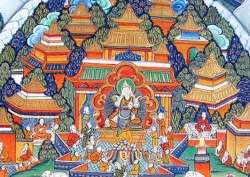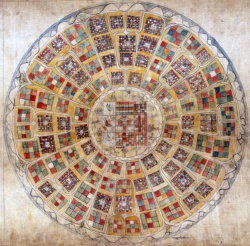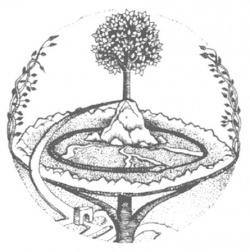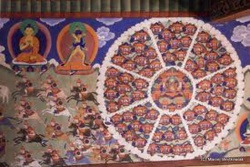Shamis-en-balkh and Historical Shambhala
J. Harmatta and BA LiTvinsky present a different view (History of civilizations of Central Asia, Vol. III, p. 371). They argue that the famous Barmakid family were apparently the descants of the Hephthalite pramukhas of the Naubahar at Balkh. According to them the Hepthalite ruler of Balkh bore the Bactrian title sava (King), while the name of his son, Pariowk (in Armenian, clerical error for Parmowk) or Barmuda, Parmuda (in Arabic and Persian, clerical error for Barmuka, Parmuka) goes back to the Buddhist title pramukha. It shows that he was the lord and head of the great Buddhist Centre Naubahar at Balkh. His dignity and power were thus more of an ecclesiastic than of secular nature.
"Interestingly in the Hephthalite dominion Buddism and Hinduism was predominant but there was also a religious sediment of Zoroastrianism and Manichaeism."Balkh had some 100 Buddhist monasteries and 30,000 monks. Outside the town was a large Buddhist monastery, later known as Naubahar. Termez had 10 sangharamas (monasteries) and perhaps 1,000 monks.....Litvinovsky, Boris Abramovich. History of civilizations of Central Asia, Volume 3. UNESCO; published by Motilal Banarsidass. p. 149.
The Hephthalites were a Central Asian nomadic confederation of the AD 5th-6th centuries whose precise origins and composition remain obscure. According to Chinese chronicles, they were originally a tribe living to the north of the Great Wall and were known as Hoa or Hoa-tun. Elsewhere they were called White Huns....They displaced the Scythians and conquered Sogdiana and Khorasan before AD 425. Scholars believe that the Hephthalites constituted a second "Hunnish" wave who entered Bactria early in the fifth century AD, and who seem to have driven the Kidarites into Gandhara.
"Balkh came under Hepthalites or Huns by the of 4th Century A.D...... Kanishka had been the first Buddhist to rule Balkh. The early Huns followed a religion akin to Zorastrianism and worshipped fire and Sun. Subsequently, Hun Kings became followers of Buddhism...."
In the gravitational center of these domains, the Hephthalites successfully defended the territory of Herat Province, "the breadbasket of Central Asia," against all comers, including the Persian Sassanids and the Gupta Dynasty in India, for about 200 years.....Today nothing at all remains of them except a handful of silver coins.
The Encyclopedia Iranica paints a very pleasant picture of these extinct wanderers.....Procopius claims that the Hephthalites live in a prosperous territory, are the only Huns with fair complexions, do not live as nomads, acknowledge a single king, observe a well-regulated constitution, and behave justly towards neighboring states.......At the summit of their power around 550 AD, the Hephthalites ruled a roughly triangular empire extending over most of Afghanistan, Pakistan, Turkmenistan, Tajikistan, Kyrgystan, and Uzbekistan.
Newly-discovered ancient writings found in Afghanistan reveal that the Middle Iranian Bactrian language written in Greek script was not brought there by the Hephthalites, but was already present from Kushan times as the traditional language of administration in this region.
According to Xuanzang, the third Chinese pilgrim who visited the same areas as Song Yun about 100 years later, the capital of Chaghaniyan had five monasteries......"In the Hephthalite dominion Buddism was predominant but there was also a religious sediment of Zoroastrianism, Manichaeism, and Nestorian Christianity." Balkh had some 100 Buddhist monasteries and 3,000 monks. Outside the town was a large Buddhist monastery, later known as Naubahar. Termez had 10 sangharamas (monasteries) and perhaps 1,000 monks.
Also known as: Cao, Ephthalites, Hayathelaites, Hephtal, He-ta, Hoa; Hoa-Tun; From: Encyclopedia of Ancient Asian Civilizations......The Hephthalite Huns were a people of shadowy origins who ruled much of Central Asia and northern India from about 450 to 550 CE. The word Hephthalite means "valiant" or "courageous," and the Sassanian rulers, who resisted the initial westward expansion of the Huns, rightly feared their prowess as mounted cavalry and archers. Their coins bore a Bactrian script, and they probably spoke an Iranian language. A description by the sixth-century historian Procopius of Caesarea noted that they were ruled by one king and resembled the Byzantine state in their legal system. There is also evidence in their conflict with the Sassanian kings Yazgird II and Peroz that they had a powerful army and observed sealed treaties over fixed frontiers.
The historical sources for the Hephthalites are fragmentary and at times contradictory, but it seems that while some of the population continued the typically nomadic life on the steppes, the elite became increasingly sedentary and occupied permanent walled towns or cities. One report describes the king's gold throne and magnificent dress. Their coinage reveals kings, but there also appear to have been regional rulers. Little archaeological research has been undertaken on the major settlements of the Hephthalite empire. Balkh (Afghanistan) is known to have been one of their centers, and Xuanzang described it as their capital. It was, he said, defended with strong walls but was not densely populated. Termez, on the Amu Dar'ya River, and Budrach were other cities of this period. The latter incorporated a citadel and covered an area of about 50 hectares (125 acres). Kafyr-kala, in the Vaksh Valley of Tajikistan was a walled regional capital with a citadel and a palace. The life led in such centers is illustrated by the painted feasting scene at Balalyk-tepe in the upper valley of the Amu Dar'ya River in Uzbekistan, which shows aristocratic men and women shielded by servants holding umbrellas. A second elite feasting scene is depicted on a silver dish from Chilek, in which female dancers are entertaining royalty. In Afghanistan, the massive rock-cut images of the Buddha at Bamiyan in Afghanistan, the largest such statues known before their destruction by the Taliban in 2001, probably date within the period of the Hephthalite empire.
Encyclopedia of Ancient Asian Civilizations.......Balkh is a settlement strategically placed north of the Hindu Kush range and south of the Amu Dar'ya River and was an important staging post on the ancient Silk Road that linked Rome with India and China. It was occupied by or under the control of most of the major powers that successively controlled this region, including the Sasanid dynasty, whose coinage was minted there under the title Bahlo, their name for the city. There were also periods of Bactrian Greek, Mauryan, Saka, and Kushan occupation. When Xuanzang, the Chinese Buddhist pilgrim, visited Bactria in the seventh century CE, he found that Balkh, the capital, was occupied by a sizable population of Buddhist monks. There are many early Buddhist foundations in the vicinity of the city, making Balkh one of the most westerly points of Buddhist expansion. One of these, the stupa known as Tope y-Rustam, is probably the same monument described by Xuanzang as Navasangharama.
Although the Hephthalites dominated much of Central Asia and Northern India at the height of their power (approximately 460 to 570), little information about their civilization is available to us. Their name derives from the Byzantine "Ephthalites," and they were alternatively known as Ye-Ta to the Wei dynasty and Hunas to the Gupta Empire. They are also referred to as "White Huns" in some histories, a term derived from a quotation from Procopius' History of the Wars, in which he writes, "The Ephthalites are of the stock of the Huns in fact as well as in name; however they do not mingle with any of the Huns known to us.... They are the only ones among the Huns who have white bodies and countenances which are not ugly."
Wei-era documentation records that the Hephthalites worshiped Heaven and also fire, also mentioned by Procopius.
"J. Harmatta and BA LiTvinsky present a different view (History of civilizations of Central Asia, Vol. III, p. 371). They argue that the famous Barmakid family were apparently the descants of the Hephthalite pramukhas of the Naubahar at Balkh. According to them the Hepthalite ruler of Balkh bore the Bactrian title sava (King), while the name of his son, Pariowk (in Armenian, clerical error for Parmowk) or Barmuda, Parmuda (in Arabic and Persian, clerical error for Barmuka, Parmuka) goes back to the Buddhist title pramukha. It shows that he was the lord and head of the great Buddhist Centre Naubahar at Balkh. His dignity and power were thus more of an ecclesiastic than of secular nature.".....http://ikashmir.net/rktamiri/barmarks.html
"...the spoken language of the Hephthalites was an East Iranian language different from the Baktrian language that was utilized as the "official language" and minted on coins.....According to B.A. Litvinsky, the names of the Hephtalite rulers used in the Shahnameh are Iranian. According to Xavier Tremblay, one of the Hephthalite rulers was named "Khingila", which has the same root as the Sogdian word xnγr and the Wakhi word xiŋgār, meaning "sword". The name "Mihirakula" is thought to be derived from mithra-kula which is Iranian for "the Sun family", with kula having the same root as Pashto kul, "family". "Toramāna" is also considered to have an Iranian origin. Accordingly, in Sanskrit, mihira-kula would mean the "kul (family) of mihira (Sun)", although mihira is not purely Sanskrit but is a borrowing from Middle Iranian mihr. Janos Harmatta gives the translation "Mithra's Begotten" and also supports the Iranian theory."....http://en.wikipedia.org/wiki/Hephthalite_Empire
"Mihirakula (Chinese: 大族王) was one of the most important Hephthalite emperors, whose empire was in the present-day territories of Afghanistan, Pakistan and northern and central India. Mihirakula was a son of Toramana who was a tegin of the Indian part of the Hephthalite Empire. Mihirakula ruled his empire from 515 to 530.....The name "Mihirakula" is thought to be derived from mithra-kula which is Iranian for "the Sun family".... in Sanskrit, mihira-kula would mean the "kul (family) of mihira (Sun)", although mihira is not purely Sanskrit but is a borrowing from Middle Iranian mihr."....http://en.wikipedia.org/wiki/Mihirakula
This research explores the Central Asian origins of the Shambhala Teachings and the region of ancient 'Shamis en Balkh' (36° N 66° E) as the location (before the 8th Century AD) of the 'legendary' Kingdom of Shambhala....known as 'Shams-i-Bala', it was located in the once extremely rich and fertile Oxus River region of Bactria and encircled by the great Pamir and Caucasus Asia Mountains.....With Tagzig to the west, Oddiyana to the east, Zhang-Zhung to the south-east, Gandharva to the south, Airyana Vaeja to the north and Uighur/Kunlun to the north east, legendary Balkh was a spiritual vortex and the location of a great pre-historic Sun Temple and a very important early Buddhist center...Shamis en Balkh was an important trade center in 5000 BC, reached it height about 2400 BC and was still an impressive city when Marco Polo visited in 1275 AD......



